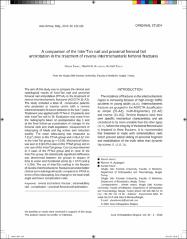A comparison of the InterTan nail and proximal femoral fail antirotation in the treatment of reverse intertrochanteric femoral fractures
Abstract
The aim of this study was to compare the clinical and radiological results of InterTan nail and proximal femoral nail antirotation (PFNA) in the treatment of reverse intertrochanteric fractures (AO/OTA 31-A3). The study included a total of consecutive patients who presented at trauma centre with a reverse intertrochanteric fracture between in the last 7 years. Treatment was applied with PFNA in 33 patients and with InterTan nail in 36. Evaluation was made from the radiographs taken on postoperative day 1 and at the final follow-up examination of changes in the femoral neck and shaft angulation, measurement of telescoping of blade and lag screws and reduction quality. The mean telescoping was measured as 7.21 +/- 7.13mm in the PFNA group and 4.18 +/- 4.32 mm in the InterTan group (p = 0.039). Mechanical failure was seen in 8 (24.2%) cases in the PFNA group and in one case of the InterTan group. Cut-out was observed in 4 cases of the PFNA group and in none of the InterTan group. No statistically significant difference was determined between the groups in respect of time to union and functional scores (p = 0.573 and p = 0.294). The use of InterTan nailing in the fixation of reverse intertrochanteric fractures provided better clinical and radiological results compared to PFNA in terms of less telescoping, less change in the neck shaft angle and lower complication rates.


















